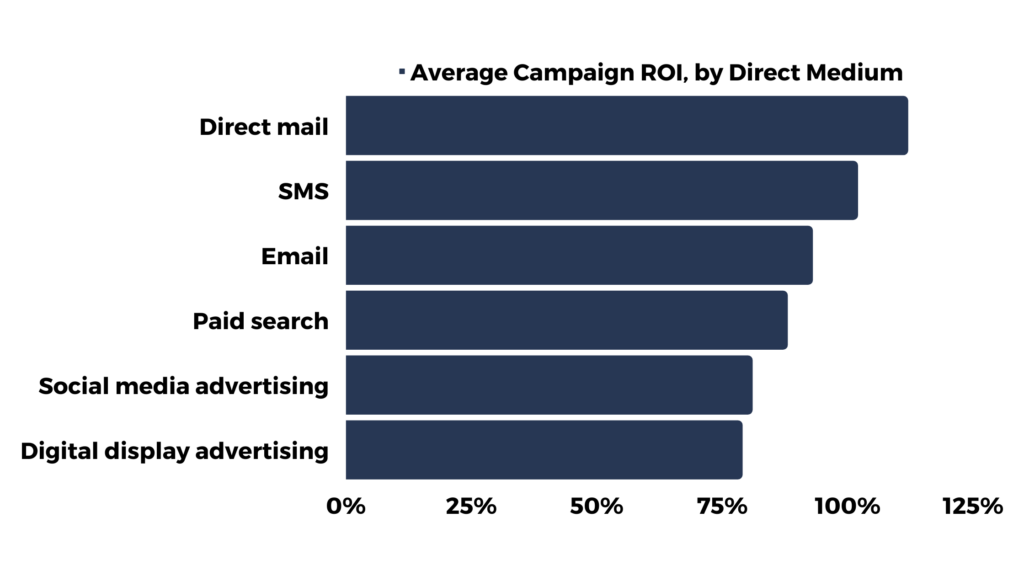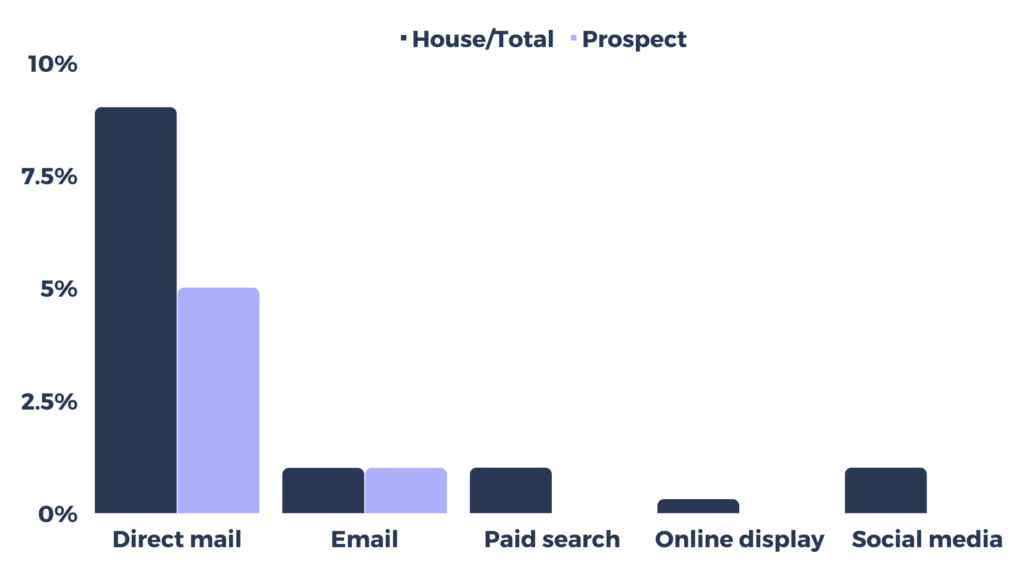
Why Use Direct Mail Marketing in Overall Marketing Strategy
Despite the rise of email and other digital communications, direct mail is still a powerful marketing tool. A recent study found that 66% of consumers prefer to receive marketing information through the mail.
Direct mail may sound outdated, but stats show that the response rate for direct mail is 3-5% compared to 0.2% for email. Direct mail can be an effective way to reach your target audience and generate leads or sales.
This blog includes the top 10 reasons direct mail marketing should be a part of your marketing mix.
Direct mail is cost-effective and has a higher ROI
Direct mail offers increased cost-effectiveness in comparison to other forms of marketing and has a higher ROI due to its relatively low cost.

ANA analysis from 2022 reveals that those organizations who implemented direct mail campaigns utilizing letter-sized envelopes sent to prospect lists saw a notable return on investment (ROI). On average, the ROI for direct mail was 112%, demonstrating this method’s effectiveness in connecting with potential customers.
Direct mail has long been one of the most successful channels for reaching out to potential customers and delivering meaningful results. With its high returns, businesses can be sure that investing in a direct mail advertising is an excellent way to optimize their budget and maximize their profits.
Given its proven efficacy and versatility in today’s business world, investing in a well-crafted direct mail campaign is highly recommended for any organization looking to drive growth through targeted outreach. From boosting brand awareness to increasing conversions, direct mail offers many benefits that make it a viable solution in an ever-changing marketing landscape.
Direct mail has better response rates compared to email
Direct mail offers great response rates far higher than those offered by email. With an average response rate of 5.3% for physical mail sent to households and 2.9% for prospect lists, it is clear why direct mail is a preferred marketing channel for many businesses.
It should come as no surprise that direct mail yields these significantly better results when compared to the much lower click-through and response rates associated with emails (typically about 2% or 3% and 0.6%, respectively).

The reasons behind this difference are rooted in the way people consume media in a digital advertising age: while people’s attention spans are becoming shorter and they often ignore emails, direct mail stands out as it requires physical action, opening the envelope, reading through the content and can therefore capture their attention more effectively.
Take advantage of the high response rates associated with direct mail advertising.

Direct mail can be highly targeted
With direct mail, businesses can pinpoint the exact target audience they want to reach and customize messages for each demographic.
Using MarTech Solution by Oppizi, businesses and organizations can segment their lists into specific geographic regions or other criteria to create highly targeted direct mail marketing campaigns. Companies can customize messages for different audiences depending on whether they are located in urban or rural areas or have certain demographic traits like age and income level. Businesses can maximize their return on investment by sending only the most relevant messaging to each segment.

Powered with tracking capabilities and the ability to segment audiences based on geography or demographics, Oppizi provides businesses with an effective way of engaging with the target audience while maximizing ROI through improved engagement rates.
Direct mail is highly personalized
Direct mail campaigns are highly personalized and can be tailored to suit the individual needs of each recipient. The contents of a direct mail campaign can be changed to better target a specific audience or to emphasize particular points or messages. This could include varying the message type, adjusting the tone and language used, and selecting and modifying visual elements such as images and graphics.
Regarding personalization, direct mail has the advantage over other marketing channels because it allows for more detailed customization. From the address on the envelope to the call-to-action at the end of the mailing, each element can be tailored according to individual customer data profiles, ensuring that your message is directly relevant to them.

Personalized direct mail pieces include customized images, messages tailored to the recipient’s interests, dynamic calls-to-action with relevant offers based on past behaviour or conversations with customer service reps, targeted discounts based on past purchases, and so much more. Personalization can extend beyond the content and expand into other areas, such as envelope design or packing materials.
At an even deeper level of personalization, advanced printing technologies allow for variable data printing (VDP). This process leverages customer data to create unique versions of direct mail pieces for each recipient – including user names and images throughout – resulting in a much more robust connection between customer and brand.
Direct mail is trackable
Direct mail marketing campaigns are easily trackable and can provide invaluable insights into consumer behaviour. Companies can measure the return on investment (ROI) from direct mail campaign to determine whether or not their efforts were worth the cost. Post-campaign metrics such as ROI (Return on Investment), Customer Lifetime Value (CLV) or Cost Per Acquisition (CPA) provide invaluable inputs for further optimization.

With tracking methods such as barcodes, QR codes, and personalized URLs, companies can gather valuable data about who is engaging with their campaigns.
Measuring these results also enables businesses to optimize spending and allocate resources more effectively. With detailed analytics, direct mail campaigns can become more accurately tailored to individual recipients, which leads to higher engagement and conversion rates.
Tracking the effectiveness of direct mail campaigns is also helpful when segmenting customer audiences based on predefined criteria. For instance, a business might choose to send targeted offers to only those customers who have been identified as likely to respond positively.
Direct mail can be used in conjunction with digital marketing
Direct mail is an often overlooked tool in a comprehensive digital marketing strategy, but it can be incredibly effective in conjunction with other online channels. Through direct mail, businesses can target potential customers through physical advertising, increasing their reach and visibility. By combining direct mail with different digital advertising strategies, such as email campaigns, search engine optimization (SEO), pay-per-click (PPC) advertising, and social media marketing, companies can maximize their return on investment while boosting brand awareness and engagement.
The benefit of using both digital channels and direct mail is that it helps create a unified presence on both digital and physical platforms. Integrating direct mail with other forms of marketing allows companies to communicate a consistent message across multiple platforms that reach the exact audience simultaneously. Through this method, businesses can effectively increase their brand recognition and stay in mind with consumers when making purchase decisions.

In addition to its cost-effectiveness and reachability, direct mail, in combination with other forms of marketing, allows companies to measure response rates more accurately than they would be able to do through digital channels alone. Because direct mail requires an extra step from the consumer, that is, opening and taking action on an envelope, companies can track how many people respond positively right down to the individual level. This provides valuable insight into which campaigns are most effective so businesses can double down on successful strategies or tweak ones that aren’t performing as well as expected.
Incorporating direct mail into a comprehensive digital marketing strategy is essential for today’s forward-thinking brands. By combining traditional methods of communication with cutting-edge technology solutions, companies can create highly effective campaigns that attract new customers and keep existing ones engaged for extended periods.
Utilizing digital channels and direct mail together creates opportunities for increased brand visibility, better customer engagement levels, higher ROI figures, improved response rates monitoring, and more precise targeting capabilities – all invaluable assets for any business looking to strengthen its marketing strategy over time.

Direct mail gets undivided attention
Direct mail still has the edge over digital or social media marketing when it comes to getting undivided attention from consumers. This is because when consumers open their mailbox, they’re not distracted by notifications or ads as they are online. This makes direct mail a powerful marketing tool that can reach an audience with laser-like precision.
A well-crafted direct mail campaign will also be more impactful to the consumer. Traditional mail gives marketers the ability to craft an immersive experience for their audience, allowing them to connect emotionally and provide details and facts about their product or service. It also allows marketers to leverage creative elements such as custom packaging, personalized messages and interactive components.
Consumers are more likely to keep and reference physical mail than digital media, which can quickly become lost in the virtual abyss. Since physical mail must be opened, there is no chance of it getting blocked by spam filters like email often does.
Conclusion
Overall, Direct Mail provides an effective way to reach customers with high-impact messaging while giving marketers control over content delivery and effective tracking tools to measure success – all while avoiding the potential pitfalls of digital marketing channels like email and social media.




